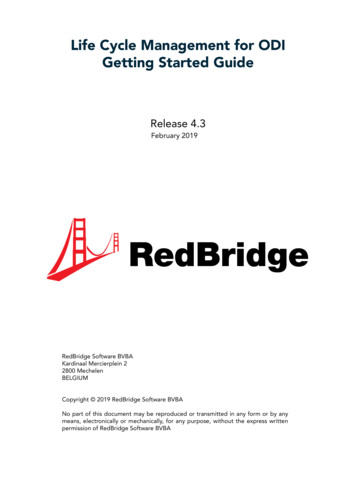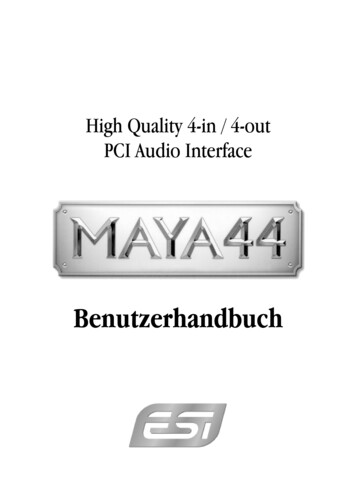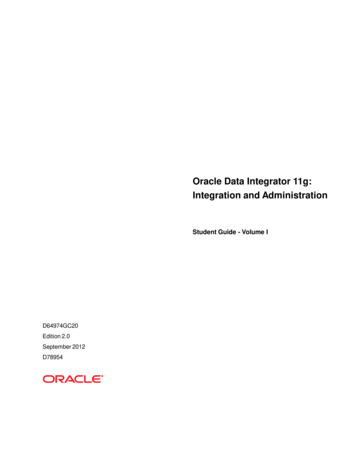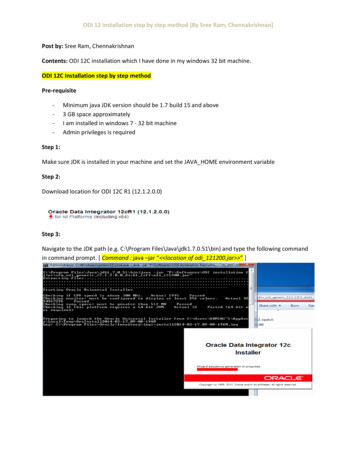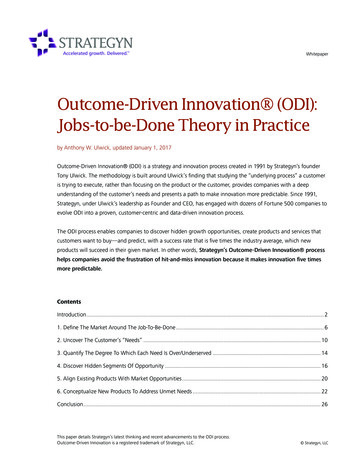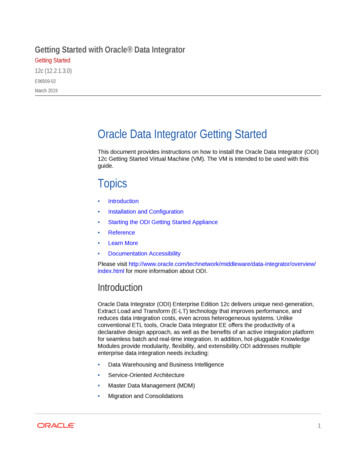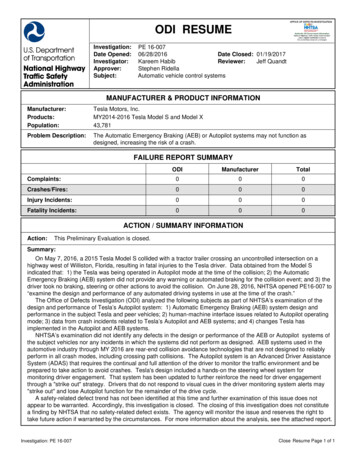
Transcription
ODI RESUMEInvestigation:Date Opened:Investigator:Approver:Subject:PE 16-00706/28/2016Date Closed: 01/19/2017Kareem HabibReviewer:Jeff QuandtStephen RidellaAutomatic vehicle control systemsMANUFACTURER & PRODUCT INFORMATIONManufacturer:Products:Population:Tesla Motors, Inc.MY2014-2016 Tesla Model S and Model X43,781Problem Description:The Automatic Emergency Braking (AEB) or Autopilot systems may not function asdesigned, increasing the risk of a crash.FAILURE REPORT ires:000Injury Incidents:000Fatality Incidents:000ACTION / SUMMARY INFORMATIONAction:This Preliminary Evaluation is closed.Summary:On May 7, 2016, a 2015 Tesla Model S collided with a tractor trailer crossing an uncontrolled intersection on ahighway west of Williston, Florida, resulting in fatal injuries to the Tesla driver. Data obtained from the Model Sindicated that: 1) the Tesla was being operated in Autopilot mode at the time of the collision; 2) the AutomaticEmergency Braking (AEB) system did not provide any warning or automated braking for the collision event; and 3) thedriver took no braking, steering or other actions to avoid the collision. On June 28, 2016, NHTSA opened PE16-007 to“examine the design and performance of any automated driving systems in use at the time of the crash.”The Office of Defects Investigation (ODI) analyzed the following subjects as part of NHTSA’s examination of thedesign and performance of Tesla’s Autopilot system: 1) Automatic Emergency Braking (AEB) system design andperformance in the subject Tesla and peer vehicles; 2) human-machine interface issues related to Autopilot operatingmode; 3) data from crash incidents related to Tesla’s Autopilot and AEB systems; and 4) changes Tesla hasimplemented in the Autopilot and AEB systems.NHTSA’s examination did not identify any defects in the design or performance of the AEB or Autopilot systems ofthe subject vehicles nor any incidents in which the systems did not perform as designed. AEB systems used in theautomotive industry through MY 2016 are rear-end collision avoidance technologies that are not designed to reliablyperform in all crash modes, including crossing path collisions. The Autopilot system is an Advanced Driver AssistanceSystem (ADAS) that requires the continual and full attention of the driver to monitor the traffic environment and beprepared to take action to avoid crashes. Tesla's design included a hands-on the steering wheel system formonitoring driver engagement. That system has been updated to further reinforce the need for driver engagementthrough a "strike out" strategy. Drivers that do not respond to visual cues in the driver monitoring system alerts may"strike out" and lose Autopilot function for the remainder of the drive cycle.A safety-related defect trend has not been identified at this time and further examination of this issue does notappear to be warranted. Accordingly, this investigation is closed. The closing of this investigation does not constitutea finding by NHTSA that no safety-related defect exists. The agency will monitor the issue and reserves the right totake future action if warranted by the circumstances. For more information about the analysis, see the attached report.Investigation: PE 16-007Close Resume Page 1 of 1
1.0 INTRODUCTIONOn May 7, 2016, a 2015 Tesla Model S collided with a tractor trailer crossing an uncontrolledintersection on a highway west of Williston, Florida, resulting in fatal injuries to the Tesla driver. Dataobtained from the Model S indicated that: 1) the Tesla was being operated in Autopilot mode at the timeof the collision; 2) the Automatic Emergency Braking (AEB) system did not provide any warning orautomated braking for the collision event; 3) the driver took no braking, steering or other actions to avoidthe collision; and 4) the last recorded driver action was increasing the cruise control set speed to 74 mphless than two minutes prior to impact. The crash occurred on a clear day with dry road conditions. OnJune 21, 2016, NHTSA deployed a Special Crash Investigations team to the crash site to evaluate thevehicle and study the crash environment. NHTSA’s crash reconstruction indicates that the tractor trailershould have been visible to the Tesla driver for at least seven seconds prior to impact. On June 28, 2016,NHTSA opened PE16-007 to “examine the design and performance of any automated driving systems inuse at the time of the crash.”The Office of Defects Investigation (ODI) analyzed the following subjects as part of NHTSA’sexamination of the design and performance of Tesla’s Autopilot system: 1) AEB design and performancein the subject Tesla and peer vehicles; 2) human-machine interface issues related to Autopilot operatingmode; 3) data from crash incidents related to Tesla’s Autopilot and AEB systems; and 4) changes Teslahas implemented in the Autopilot and AEB systems.2.0 AEB SYSTEM2.1 AEB technologies. Automatic Emergency Braking includes the following crash avoidancetechnologies: Forward Collision Warning (FCW), Dynamic Brake Support (DBS), and Crash ImminentBraking (CIB). An FCW is presented to the driver if the system predicts a crash with an object in thevehicle’s forward path is imminent. To be effective, such alerts are provided with sufficient lead-time forthe driver to assess the potential hazard, and to respond with the appropriate braking or steering needed toavoid the crash. If the driver chooses to avoid the crash by braking, but does not apply sufficient brakingto do so, DBS automatically supplements their application. If the driver does not take action to avoid thecrash, CIB automatically applies the vehicle’s brakes so that it may be mitigated or avoided.2.2 Background. AEB technologies have been in use for over 10 years. In September 2007, aNHTSA-sponsored project was initiated by the Crash Avoidance Metrics Partnership (CAMP) “todevelop test methods for evaluating crash imminent braking systems and to establish benefits estimationmethods for assessing their effectiveness at reducing the severity of potential injuries in vehicle crashes.”1The final report from this project, released in September 2011, validated the effectiveness of radar,camera and radar/camera fusion systems as rear-end collision mitigation or avoidance technologies.2 Thereport also identified several crash modes that were not validated by the project, including straightcrossing path (SCP)3 and left turn across path (LTAP) collisions:1Crash Imminent Braking (CIB) First Annual Report. (2010). DOT HS 811 340. National Highway Traffic SafetyAdministration. Washington, DC.2Objective Tests for Imminent Crash Automatic Braking Systems Final Report Volume 1 of 2. (2011). DOT HS811 521. National Highway Traffic Safety Administration. Washington, DC.3The classic example of an SCP crash is a laterally approaching vehicle in a traffic intersection. Challengesassociated with these crash modes increase as speeds of target and/or host vehicle increase.
2The test methods representing Straight Crossing Path [emphasis added], Left TurnAcross – Opposite Direction, Opposite Direction, and pole/tree crash scenarios wereall designated as ‘Test Method Not Validated – Beyond Scope of CIB Project.’ Whiletest scenarios were developed and demonstrated for these crash conditions, CIBsystem performance, regardless of system configuration or settings, were not capableof reliably responding to these tests. Due to the difficulty in predicting the pre-crashevents that lead up to these crash types, the difficulty in balancing CIB activations forthese crashes with potential increases in undesirable false activation, and many otherfactors, these scenarios are also not likely to be near-term deployable features of CIBsystems and may be better addressed through other active safety technologies.4Figure 1 shows a straight crossing path test conducted as part of the CIB project. The report providesthe following assessment of the test result, “The limited time the target is in the field of view prior toimpact challenges the system’s ability to perform threat assessment and apply the CIB system. A target isusually recognized very late or not at all prior to impact.” 5Figure 1. CIB Project Straight Crossing Path Test Scenario.Since model year (MY) 2010, NHTSA has conducted testing of FCW system performance as part ofits New Car Assessment Program (NCAP). The tests include the rear-end collision crash modes validatedby the CIB project: Lead Vehicle Stopped (LVS), Lead Vehicle Moving (LVM), and Lead VehicleDecelerating (LVD). On November 5, 2015, the agency announced it would be adding AEB systemevaluations to NCAP effective for the 2018 model year. In March 2016, NHTSA issued a joint statementwith the Insurance Institute for Highway Safety (IIHS) providing information related to the commitment4Objective Tests for Imminent Crash Automatic Braking Systems Final Report Volume 1 of 2, page 84 (2011).DOT HS 811 521. National Highway Traffic Safety Administration. Washington, DC.5Objective Tests for Imminent Crash Automatic Braking Systems Final Report Volume 2 of 2, page L-51 (2011).DOT HS 811 521A. National Highway Traffic Safety Administration. Washington, DC.
3by 20 automobile manufacturers, representing 99 percent of the U.S. new-car market, to voluntarily makeAEB “standard on virtually all light-duty cars and trucks with a gross vehicle weight of 8,500 lbs. or lessno later than September 1, 2022, and on virtually all trucks with a gross vehicle weight between 8,501 lbs.and 10,000 lbs. no later than September 1, 2025.” The predicted safety benefits cited in the statement arelimited to rear-end crashes:IIHS research shows that AEB systems meeting the commitment would reduce rear-endcrashes [emphasis added] by 40 percent. IIHS estimates that by 2025 – the earliestNHTSA believes it could realistically implement a regulatory requirement for AEB – thecommitment will prevent 28,000 crashes and 12,000 injuries.6The capabilites of AEB systems have continually improved in performance and capabilities asautomobile manufacturers and suppliers refine sensor packages and the algorithms that perform the objectclassifications and make the braking decisions (e.g., pedestrian collision avoidance). Recognizing this,ODI surveyed a dozen automotive manufacturers and several major suppliers to determine if the AEBcapabilities in crossing path collisions had changed since the CAMP CIB project was completed. None ofthe companies contacted by ODI indicated that AEB systems used in their products through MY 2016production were designed to brake for crossing path collisions.2.3 Tesla AEB system. The Tesla AEB system is a radar/camera fusion system that is functionalwhen switched ON regardless of Autopilot status. The driver can switch AEB ON/OFF on the DriverAssist page accessible via a display mounted in the center of the dashboard. The AEB is default ON foreach new ignition cycle. The driver can select the timing of FCW alerts with four options: Early,Medium, Late, or OFF. If FCW is OFF, the driver will still get a Brake Capacity Warning (BCW) whendriving in Traffic-Aware Cruise Control (TACC) mode (see Section 3 below). BCW alerts the driverwhen the closing speed to a lead vehicle may be too great to avoid a collision with the standard TACCdeceleration limits. Adjusting the timing of the FCW alert does not affect the activation timing of theTesla AEB system.Both the radar and camera sub-systems are designed for front-to-rear collision prediction mitigationor avoidance.7 The system requires agreement from both sensor systems to initiate automatic braking.The camera system uses Mobileye’s EyeQ3 processing chip which uses a large dataset of the rear imagesof vehicles to make its target classification decisions. Complex or unusual vehicle shapes may delay orprevent the system from classifying certain vehicles as targets/threats.NHTSA conducted a series of test track-based AEB performance evaluations shortly after the Maycrash using a 2015 Tesla Model S 85D and a 2015 Mercedes C300 4Matic peer vehicle. The vehicleswere tested in the three rear-end collision crash modes (LVS, LVM, and LVD) and three different vehicleoperating modes: manual driving; adaptive cruise control (ACC) systems activated; and ACC and LaneCentering Control (LCC) systems activated. This testing confirmed that the AEB systems in the Teslaand peer vehicle were able to achieve crash avoidance in a majority of the rear-end scenarios tested; thatACC generally provided enough braking to achieve crash avoidance without also requiring CIB to6Fact Sheet, Auto Industry Commitment to IIHS and NHTSA on Automatic Emergency Braking. (2016). NationalHighway Traffic Safety Administration & Insurance Institute for Highway Safety. Washington, DC.7The system is also designed to detect and avoid impacts with pedestrians and stationary objects in the path of theTesla when operating with TACC enabled.
4intervene; and that neither vehicle effectively responded to a realistic appearing artifical “target” vehiclein the SCP or LTAP scenarios.ODI’s analysis of Tesla’s AEB system finds that 1) the system is designed to avoid or mitigate readend collisions; 2) the system’s capabilities are in-line with industry state of the art for AEB performacethrough MY 2016; and 3) braking for crossing path collisions, such as that present in the Florida fatalcrash, are outside the expected performance capabilities of the system.83.0 AUTOPILOTThe Autopilot system is an advanced driver assistance system (ADAS), which controls vehicle speedand path by automated control of braking, steering and torque to the drive motors.9 Figure 2 shows thecomponents used by Autopilot to monitor the driving environment.10 The major subsystems associatedwith operation in Autopilot mode are TACC and Autosteer.Figure 2. 2016 Tesla Model S Driver Assistance Sensors (left) and Fields of View (right).3.1 Traffic-Aware Cruise Control (TACC). The Tesla TACC system uses information from theforward looking camera and radar sensor to determine if there is a vehicle in front of the Tesla in the samelane. If there is no vehicle in front of the Tesla, TACC maintains a set driving speed selected by thedriver. When there is a lead vehicle detected that is travelling slower that the Tesla’s set speed, theTACC will control motor torques to maintain a selected time-based distance from the lead vehicle.The Tesla Model S owner’s manual states that TACC “is primarily intended for driving on dry,straight roads, such as highways and freeways. It should not be used on city streets.” The manualincludes several additional warnings related to system limitations, use near pedestrians and cyclists, anduse on winding roads with sharp curves or with slippery surfaces or poor weather conditions. The systemdoes not prevent operation on any road types.3.2 Autosteer. The Tesla Autosteer system uses information from the forward-looking camera, theradar sensor, and the ultrasonic sensors, to detect lane markings and the presence of vehicles and objects8Object classification algorithms in the Tesla and peer vehicles with AEB technologies are designed to avoid falsepositive brake activations. The Florida crash involved a target image (side of a tractor trailer) that would not be a“true” target in the EyeQ3 vision system dataset and the tractor trailer was not moving in the same longitudinaldirection as the Tesla, which is the vehicle kinematic scenario the radar system is designed to detect.9NHTSA recognizes that other jurisdictions have raised concerns about Tesla’s use of the name “Autopilot.” Thisissue is outside the scope of this investigation.102016 Tesla Model S Owner’s Manual
5to provide automated lane-centering steering control based on the lane markings and the vehicle directlyin front of the Tesla, if present. The Tesla owner’s manual contains the following warnings: 1) “Autosteeris intended for use only on highways and limited-access roads with a fully attentive driver. When usingAutosteer, hold the steering wheel and be mindful of road conditions and surrounding traffic. Do not useAutosteer on city streets, in construction zones, or in areas where bicyclists or pedestrians may be present.Never depend on Autosteer to determine an appropriate driving path. Always be prepared to takeimmediate action. Failure to follow these instructions could cause serious property damage, injury ordeath;” and 2) “Many unforeseen circumstances can impair the operation of Autosteer. Always keep thisin mind and remember that as a result, Autosteer may not steer Model S appropriately. Always driveattentively and be prepared to take immediate action.” The system does not prevent operation on anyroad types.4.0 HUMAN MACHINE INTERFACE4.1 Automation Level. The Tesla Autopilot system is a Level 1 automated system when operatedwith TACC enabled and a Level 2 system when Autosteer is also activated. Figure 3 shows a summaryof the levels of driving automation for on-road vehicles, including the division of responsibility at eachlevel for the driver and system.11 Level 1 and 2 system require continuous attention by the operator tomonitor the driving environment and take immediate control when necessary. It is important thatoperators recognize this responsibility and understand the capabilities and limitations of the system.Figure 3. Summary of SAE International’s Levels of Driving Automation for On-Road Vehicles.The design of Level 2 partial autonomous systems should consider human-machine interface designfactors, including:12 1) provide the operator with information about system limitations; 2) include amethod for monitoring driver engagement with the driving task and assisting the driver with ed driving.pdfHuman Factors Evaluation of Level 2 and Level 3 Automated Driving Concepts – Concepts of Operation. (2014).DOT HS 812 044. National Highway Traffic Safety Administration. Washington, DC.12
6attention to the environment; 3) minimize the potential for mode confusion to occur, through intuitivefeedback from vehicle dynamics and/or warnings to the driver; and 4) consider restricting availability orperformance when used on roads that are not in the intended use operating environments.4.2 System limitations. Tesla provides information about system limitations at multiple levels,including: 1) the owner’s manual; 2) in the release notes for new software releases, which refer to theowner’s manual; 3) a user agreement required before enabling Autosteer for the first time or after anignition cycle that concluded with Autosteer being switched off; 4) a dialog box that appears every timeAutosteer is activated reminding the driver to “Always keep your hands on the wheel” and “Be preparedto take over at any time” (Figure 4); 5) the information in the user interface, which appears at all timeswhile driving - the blue shaded circle around the white steering wheel indicates Autosteer is in operation,as opposed to when the background is gray meaning Autosteer is available should the driver decide toenable it (Figure 5).Figure 4. Dialog Box that Appears Every Time Autosteer is Activated.Figure 5. Autopilot User Interface showing System Perceived LaneLines, Other Vehicles, and Ultrasonic Objects.
74.3 Driver monitoring. Tesla monitors driver engagement13 through the interactions with the steeringwheel, turn signal, and TACC speed setting stalk. If the system does not detect the driver’s hands on thesteering wheel (assessed using microtorque measurements) or other signs of driver engagement forperiods of time that vary depending on road class, vehicle speed, road curvature, and traffic conditions, anescalating series of warnings is presented. The warnings start with a visual alert indicating that hands onthe steering wheel are required. If the driver does not respond to the visual warning, an audible chime issounded after 15 seconds. A more pronounced chime is initiated if the driver does not respond afteranother 10 seconds. If the driver fails to respond to the third alert stage within five seconds, the systemgradually slows the vehicle while maintaining position in the lane. Once the driver’s hands are detectedon the steering wheel, the warnings are suspended and Autopilot operation resumes.As part of Tesla’s 8.0 over-the-air (OTA) software update in September 2016, Tesla revised thetiming of the hands-on warnings and added a feature that takes away the Autopilot driving feature for theremainder of the drive cycle if the driver fails to respond to the alerts adequately (known as an “Autopilotstrikeout” – Figure 6).Figure 6. Autosteer "Strike-Out" Alert.4.4 Mode confusion. Unexpected system response during attempted activation or inadvertentoverride of Autosteer may leave the operator unaware of the state of the vehicle (i.e., “mode confusion”).Tesla’s design is intended to protect against mode confusion at several levels, including: 1) informationavailable in the user interface regarding Autopilot availability, Autopilot state, and successful and failedtransitions between states; 2) providing audiovisual “Take Over Immediately” warning whenever thevehicle crosses a lane line or road edge, while the driver’s hands are not detected on the steering wheel,within 40 seconds of an unsuccessful activation of Autosteer or an Autosteer override; and 3) if the driverattempts to activate TACC and Autosteer with a double-pull of the cruise stalk when Autosteer is not13Driver engagement refers to the driver’s engagement in monitoring the driving environment and being prepared totake immediate action to avoid collisions, if necessary.
8available, neither feature will activate and the Autosteer indicator icon will flash orange (Figure 7) and anaudible alert will sound.4.5 Road restrictions. According to Tesla, Autosteer is designed for use on highways that have acenter divider and clear lane markings. The system does not prevent operation on any road types. Thedriver is responsible for deciding when the road type and other conditions are appropriate for systemactivation. The hands-on warnings occur more frequently as a function of vehicle speed, road class, andexistence of heavy traffic.5.0 CRASH INCIDENTS5.1 Autopilot crashes. ODI analyzed data from crashes of Tesla Model S and Model X vehiclesinvolving airbag deployments that occurred while operating in, or within 15 seconds of transitioningfrom, Autopilot mode.14 Some crashes involved impacts from other vehicles striking the Tesla fromvarious directions with little to no warning to the Tesla driver. Other crashes involved scenarios known tobe outside of the state-of-technology for current-generation Level 1 or 2 systems, such as cut-ins, cut-outsand crossing path collisions.If a vehicle driving ahead of you suddenlyswerves into your lane, the system may notbe able to automatically restore the selecteddistance. This also applies to major speeddifferences to vehicles driving ahead of you,e.g., when rapidly approaching a truck.2016 BMW 7-Series Owner’s Manual, page 174Figure 8. ACC Cut-In Scenario Warning. 2016 BMW 7-Series Owner’s Manual.Figure 9. ACC Cut-Out Scenario Warning, 2016 Volvo XC90 Owner’s Manual.14Data logs, image files, and records related to the crashes were provided by Tesla in response to NHTSAsubpoenas.
9Figures 8 and 9 show examples of warnings from peer vehicle owner’s manuals indicating that thesemodes are challenging for ACC systems, in Level 1 or 2 operating modes, and may require action by thedriver to avoid a collision. Similarly, in discussing ACC, the BMW manual describes system limitations,including that the system does not decelerate for cross traffic. 155.2 Driver behavior factors. Many of the crashes appear to involve driver behavior factors,including travelling too fast for conditions, mode confusion, and distraction. Most of these involve latesteering and/or braking actions by the driver to avoid the collision, but a few do not show any actionsprior to impact. Highway incidents, which accounted for a little over half of the crashes reviewed byODI, involved cut-ins, cut-outs, and sudden changes in traffic flow. Some crashes occurred inenvironments that are not appropriate for semi-autonomous driving (e.g., city traffic, highwayentrance/exit ramps, construction zones, in heavy rain, and road junctions/intersections).ODI’s analysis of incidents related to mode confusion did not identify a pattern of failures indicatinga potential design defect. Incidents included apparent mode confusion during attempted Autopilotactivations and mode confusion after inadvertant overrides. The incidents associated with each of thesescenarios were isolated events that involved different sets of contributing factors. Recent changesimplemented by Tesla have been made to further reduce the potential for mode confusion in the subjectvehicles.16The Florida fatal crash appears to have involved a period of extended distraction (at least 7 seconds).Most of the incidents reviewed by ODI involved events with much shorter time available for the systemand driver to detect/observe and react to the pending collision (less than 3 seconds). An attentive driverhas superior situational awareness in most of these types of events, particularly when coupled with theability of an experienced driver to anticipate the actions of other drivers. Tesla has changed its drivermonitoring strategy to promote driver attention to the driving environment.5.3 Driver distraction. Figure 10 shows the distributions of off-road glances by duration that wereobserved in a research study by General Motors of driver behaviors in vehicles with Limited-AbilityAutonomous Driving Systems (LAADS)17 when operated in SAE Level 1 and Level 2 modes.18 The datashow distractions occur in each operating mode and that the majority occur for 3 seconds or less whendriving in ACC mode or with ACC and Lane Centering Control used together. ODI’s analysis of fieldincidents found that most of the crashes developed in less than 3-4 seconds. Distractions greater thanseven seconds, such as appears to have occurred in the fatal Florida crash are uncommon, but foreseeable.15Tesla’s Model S Owner’s Manual is not as specific as the examples cited here; opting instead to identify a handfulof scenarios under which a vehicle may not be detected, followed by a broad warning: “The limitations describedabove do not represent an exhaustive list of situations that may interfere with proper operation of CollisionAvoidance Assist features. These features may fail to provide their intended function for many other reasons. It isthe driver’s responsibility to avoid collisions by staying alert and paying attention to the area beside Model S so youcan anticipate the need to take corrective action as early as possible.”16This review included an assessment of the user interface in the subject vehicles, which has a larger display andsymbols showing system status than peer vehicles with SAE Level 1 or Level 2 technologies reviewed by ODI.17LAADS are defined in the study as systems that “can control vehicle speed and steering on public roads forsubstantial distances and time” and “in some situations requires that the driver/operator intervene to assure a safeand comfortable trip,” with the latter element accounting for the “limited-ability.” The study showed that vehicleswith an “ACC and perfect Lane Centering (PADS)” system may have slightly more frequent longer duration offroad glances than vehicles with “ACC and imperfect Lane Centering (LAADS)” systems.18Salinger, J. Human Factors for Limited-Ability Autonomous Driving Systems. (2012). General Motors Research.
10Figure 10. Percentage of Off-Road Glances Across Driving Mode for Short,Intermediate and Long Time Bins.To probe the foreseeability issue further,19 the Agency issued a Special Order to Tesla to evaluate thetypes of driver misuse, including driver distraction, that were considered by the company and anysafeguards that were incorporated into the Autopilot design. It appears that over the course of researchingand developing Autopilot, Tesla considered the possibility that drivers could misuse the system in avariety of ways, including those identified above - i.e., through mode confusion, distracted driving, anduse of the system outside preferred environments and conditions. Included in the types of driverdistraction that Tesla engineers considered are that a driver might fail to pay attention, fall asleep, orbecome incapactitated while using Autopilot. The potential for driver misuse was evaluated as part ofTesla’s design process and solutions were tested, validated, and incorporated into the wide release of theproduct. It appears that Tesla’s evaluation of driver misuse and its resulting actions addressed theunreasonable risk to safety that may be presented by such misuse.205.4 Crash rates. ODI analyzed mileage and airbag deployment data supplied by Tesla for all MY2014 through 2016 Model S and 2016 Model X vehicles equipped with the Autopilot TechnologyPackage, either installed in the vehicle when sold or through an OTA update, to calculate crash rates bymiles travelled prior to21 and after Autopilot installation.22 Figure 11 shows the rates calculated by ODIfor airbag deployment crashes in the subject Tesla vehicles before and after Autosteer installation. Thedata show that the Tesla vehicles crash rate dropped by almost 40 percent after Autosteer installation.19An unreasonable risks due to owner abuse that is reasonably foreseeable (i.e., ordinary abuse) may constitute asafety-related defect. See United States v. Gen. Motors Corp., 518 F.2d 420, 427 (D.C. Cir. 1975) (“Wheels”).20Driver misuse in the context of semi-autonomous vehicles is an emerging issue and the agency intends to continueits evaluation and monitoring of this topic, including best practices for handling driver misuse as wel
the collision; and 4) the last recorded driver action was increasing the cruise control set speed to 74 mph less than two minutes prior to impact. The crash occurred on a clear day with dry road conditions. On June 21, 2016, NHTSA deployed a Special Crash Investigations team to the crash site to evaluate the vehicle and study the crash environment.
